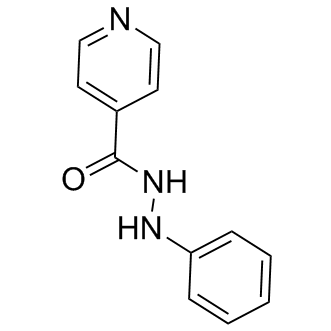| Cas No.: | 91396-88-2 |
| Chemical Name: | 4-Pyridinecarboxylicacid,2-phenylhydrazide |
| Synonyms: | NSC 14613,NSC-14613,NSC14613 |
| SMILES: | C1=CC=C(C=C1)NNC(=O)C2=CC=NC=C2 |
| Formula: | C12H11N3O |
| M.Wt: | 213.24 |
| Sotrage: | 2 years -20°C Powder, 2 weeks 4°C in DMSO, 6 months -80°C in DMSO |
| Description: | PluriSln 1 is an inhibitor of stearoyl-coA desaturase (SCD), and is a pluripotent cell-specific inhibitor. |
| In Vitro: | PluriSln 1, a small-molecule inhibitor of stearoyl-coA desaturase (SCD), on induced pluripotent stem cells (iPS)-derived cardiomyocytes (CM). PluriSln 1 treatment significantly decreases the mRNA and protein level of Nanog, a marker for both cell pluripotency and tumor progression; importantly, we provide evidence that PluriSln 1 treatment at 20 µM for 1 day significantly induces the apoptosis of Nanog-positive iPS derivates (iPSD). In addition, PluriSln 1 treatment at 20 µM for 4 days diminished Nanog-positive stem cells in cultured iPSD while not increasing apoptosis of iPS-derived CM. To investigate whether PluriSln 1 treatment prevents tumorigenicity of iPSD after cell transplantation, we intramyocardially injected PluriSln 1- or DMSO-treated iPSD in a mouse model of myocardial infarction (MI). DMSO-treated iPSD readily formed Nanog-expressing tumors 2 weeks after injection, which is prevented by treatment with PluriSln 1. Moreover, treatment with PluriSln 1 does not change the expression of cTnI, α-MHC, or MLC-2v, markers of cardiac differentiation (P>0.05, n=4). Importantly, PluriSln 1-treated iPS-derived CM exhibits the ability to engraft and survive in the infarcted myocardium[1]. |

 DC Chemicals' products qualify for U.S. tariff exemptions. We guarantee no price increases due to customs duties and maintain stable supply, continuing to deliver reliable research solutions to our American clients.
DC Chemicals' products qualify for U.S. tariff exemptions. We guarantee no price increases due to customs duties and maintain stable supply, continuing to deliver reliable research solutions to our American clients.





















